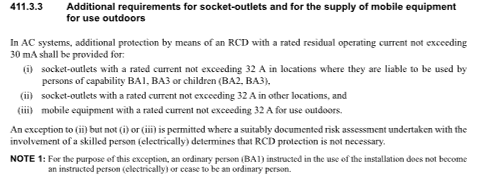I posted on this before but following a query from an estate services engineer who was attending a 2391 course, some further clarification would be helpful. This fellow has an ambulatory difficulty and is registered as disabled. The way the regulation is worded could mean that irrespective of whether the person is BA4 or BA5, if they are also BA3, a risk assessment is not a permitted exception for indent (ii).
The Irish Regs differ by just referring to ordinary persons but allow exceptions accompanied by an appropriate risk assessment for (1) sockets for use by skilled or instructed persons, (2) a specific socket outlet for a particular item of equipment. Now I don't know if IS1010-1 2020 is more closely aligned to HD60364 or if the British chaps have put their own spin on it.
